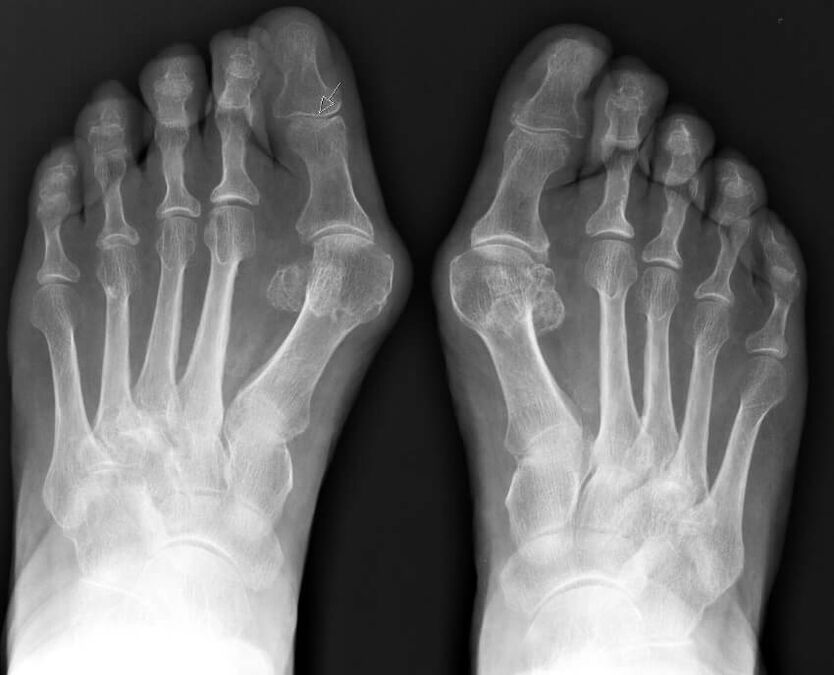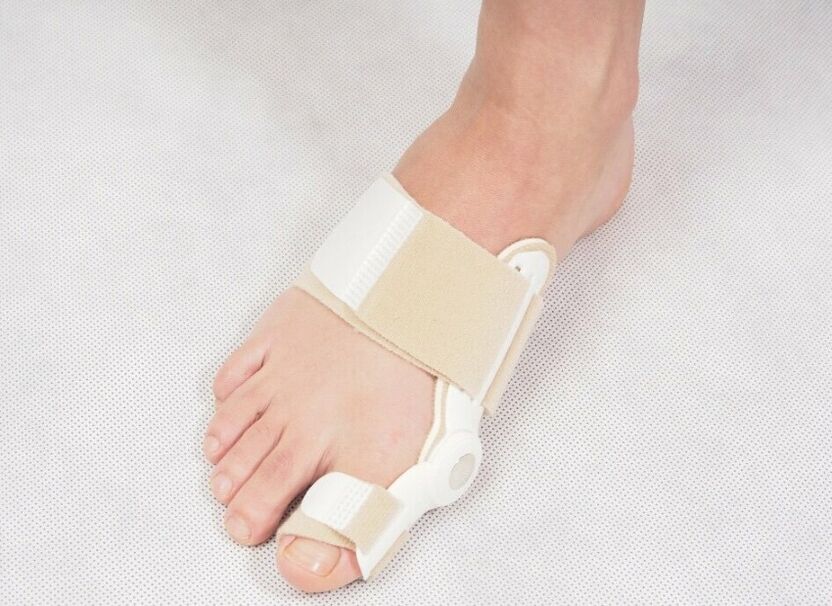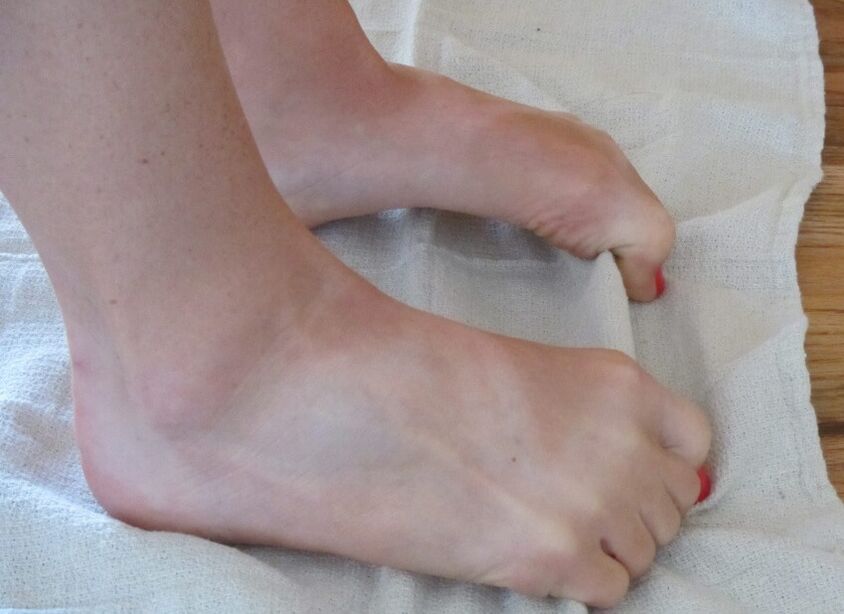Hallux valgus is a common orthopedic pathology.Usually treated surgically.Conservative methods - physical therapy, massage, physiotherapy, medications - play a significant role in the prevention and postoperative rehabilitation of hallux valgus.All methods of treating hallux valgus and big toe deviation will be discussed in the article.
What is hallux valgus
This is a disease in which the big toe moves to the side and a bone appears in the area of \u200b\u200bthe metatarsophalangeal joint.The pathology code of hallux valgus according to ICD 10 is M20.1.
Main reasonHallux valgus disease is taken into accounthereditary weakness of connective tissue.The provoking factors are:
- wear tight shoes;
- constantly walking in heels;
- excessive loads.
Less commonly, hallux valgus deformity occurs due to developmental defects, injuries, or other diseases.
Degrees of hallux valgus and their symptoms
There are different classifications of hallux valgus, which distinguish 3 or 4 degrees of pathology.The authors of the guidelines for orthopedists use the following systematization of the stages of hallux valgus:
| Grade | Angle of deformation, in degrees | Signs of deformation |
| 1 (weak) | Less than 20 | Painless lump.Sometimes discomfort appears after a long walk. |
| 2 (average) | 25-35 | Severe curvature, difficulty walking in shoes with heels and narrow toes.Possible pain, calluses and recurring inflammation of the joint. |
| 3 (heavy) | More than 35 | Severe deformity, problems choosing shoes, difficulty standing and walking, changes in gait.Frequent pain, corns, calluses and concomitant changes in the foot are typical. |

Treatment of hallux valgus deformity of the first toe
The only way to correct severe hallux valgus is surgical correction.Conservative techniques are mainly used in the initial stages of deformation.Hallux valgus is treated by an orthopedist.
The main method of determining the degree of pathology is X-rays, which are performed in two projections with a load.In addition, the doctor may prescribe plantography, CT, MRI and other studies.
Surgery to correct hallux valgus
Surgical treatment is indicated for moderate to severe hallux valgus deformity.At the patient's request, a minor surgery is sometimes performed to eliminate a cosmetic defect.There are many methods to remove a lump:
- exostosis resection;
- osteotomy;
- tendon transfer according to McBride and others.
The intervention is carried out using the usual method or by percutaneous correction (using small punctures).It is possible to remove the growth with a laser.One or more incisions are made on the side or back of the foot.The cone is cut, sometimes artificial fractures of the main phalanx or the 1st metatarsal are created, the fragments are fixed with screws.
In the initial stage of hallux valgusthe operation lasts 30-40 minutes, with severe deformation –up to an hour and a half.
Rehabilitation after removal of hallux valgus
Recovery after lump removal takes about 2 months.The key to a complete recovery is strict compliance with the orthopedist's recommendations.If the rules of rehabilitation are ignored, long-term complications may develop after surgery: reformation of hallux valgus or lifelong limitation of joint movements.
What shoes to wear after surgery
From day two you can walk in Baruk's shoes.Before the swelling goes down, you should do thismove as little as possible, most of the time the patient lies with the leg raised.After 2 weeks, walking restrictions are removed.The use of the Baruk boot remains mandatory for 1-1.5 months after bone excision.So you can wear loose sneakers or boots with a wide toe.
You have to give up heels for six months.
Is it possible to have a massage after surgery?
Massage can be done after the wound has completely healed.To improve blood circulation and lymphatic drainage, massage the entire lower part of the limb.The procedure begins with stroking.Then massage the sole and back of the foot in a circular motion.Grasp the ankle joint with your hands and move towards the knee.In the final stage, the shots are performed again.
Physical therapy for feet with screws
Physical therapy is a mandatory part of the rehabilitation period for hallux valgus and begins in the third week after surgery.First, the finger is bent and extended 3 times, held in each position for 10 seconds.The exercises are repeated 3-4 times a day.All movements are performed carefully, avoiding discomfort.
From the second month after removal of the hallux valgus, the number of repetitions increases to 7-8, the number of approaches to 6-8 per day.The discomfort is acceptable.Active movements are complemented by passive ones (using the hands).After a month and a half it is necessary to stand on tiptoe 5-6 times a day, 7-8 times, and maintain this position for about 10 seconds.
It is useful to walk on an inclined surface and climb stairs.

Corrective bandages
Corrective dressings are used after stopping use of the Baruk shoe.The products consist of two bandages connected by a zipper and fix the thumb in the abduction position.After 1-1.5 months, the bandage is replaced with silicone inserts.The leg should not be compressed– this interferes with blood circulation and can cause soft tissue injury.
How to get rid of bunion without surgery
In the advanced stages of hallux valgus it is impossible to completely cure the hallux valgus with conservative correction.All conservative methods are used only to eliminate pain, prevent complications and progression of the curvature.
To guarantee resultstreatment should be started at the first signsappearance of hallux valgus.Special exercises, massage, physiotherapy, use of orthopedic devices in combination with the use of folk remedies are effective.
Foot and toe massage
It is recommended to carry out the procedure after a warm bath.
- The leg with the deformed toe is bent at the knee and placed on the thigh of the other leg, with the sole facing inward.
- The sole is kneaded with the fist, pressing alternately on different areas of the distal part.
- The hallux valgus lump is massaged in a circular motion, then all the fingers are stretched and kneaded.
- To stimulate the outflow of blood and lymph, wrap your arms around your leg and move your palms from your foot to your knee.
Drugs for deformity
To eliminate inflammation in the hallux valgus area, topical anti-inflammatory drugs are used.
The formation of hallux valgus is accompanied by the development of arthrosis and deterioration of local metabolic processes.Therefore, to improve blood flow and stimulate tissue repair, drugs with chondroprotective effects are used.
There are special complex ointments against hallux valgus.For example, a special cream contains shark oil, natural oils and extracts that have an anti-inflammatory effect, eliminate pain and stimulate tissue regeneration.
To reduce pain and inflammation, you can use plasters, compresses with propolis, burdock and turpentine, red clay and sea salt.All compositions are applied to the protruding bone, covered with a bandage, left for 1-2 hours, then washed off.

Is it possible to correct hallux valgus with exercises?
Hallux valgus exercises can strengthen ligaments and muscles and provide a positive effect on small bones.Therapeutic gymnastics is performed after warming the hallux valgus deformity by massage.Perform the following exercises:
- Walk alternately on your heels with support on the outer and inner edges of the foot.
- Walking on a suspended carpet.
- Roll a stretchy ball.
- Extension and compression of the toes in a sitting position.
- Grasp objects (pencils, napkins, small toys).
- Draw various shapes in the air.
- Stretch the elastic band on the big toes by spreading your feet.
- Passive flexion and extension of the affected joint using the hands.
Exercises are performed daily, complemented by free stretching and stroking to relieve muscle tension.Only constant loads can influence the course of the disease.
Orthopedic devices
Taking into account the material, all devices for hallux valgus are divided into three groups: soft, semi-rigid, hard.Soft ones are used during the day, semi-hard ones - up to several hours.The rigid ones are designed to secure the foot during the night.
Depending on the type of construction, there are:
- Inserts between the fingers— correct the position of the first finger in the early stages of the deformity or in the postoperative period.Made of soft silicone.
- Sole pads- soft products used to improve shock absorption.They are sometimes available with a septum that eliminates the bunion.
- Correctors and bandages— recommended for moderate and severe stages.They can be soft or semi-rigid and contain a significant part of the foot.They are also used for valgus feet.
- Orthopedic splints- adjust the angle of the hallux valgus.Used in the later stages and only at night, as they are incompatible with shoes.
Physiotherapy for hallux valgus
Physiotherapeutic procedures are considered part of a comprehensive treatment and go well with massage and physical therapy.The following methods are used:
- Paraffin therapy— provides deep warming of muscles and ligaments, improves blood circulation, activates local metabolism.
- Therapeutic mud- have the same effect as paraffin.Relieves muscle tension.
- Laser therapy— helps expand capillaries, reduce swelling and improve protein absorption by cells.
- Ultrasound therapy- activates metabolism and microcirculation in tissues.Stimulates collagen production.Reduces pain and swelling in the bunion area.
- Shock wave therapy— eliminates stagnant processes, stimulates blood flow, improves the supply of oxygen and nutrients and activates regeneration.It acts effectively not only on ligaments and muscles, but also on osteochondral tissue.
Prevention of hallux valgus
Hallux valgus prevention should start early.Particular attention should be paid to the health of children's feet, whose family has relatives with hallux valgus with bumps on their thumbs.Hallux valgus is formed when there is transverse flat foot, so children and adults with this pathology must regularly perform exercises to strengthen the ligament-muscular system.
It is important to choose the right shoes: wide, with stable soles, made of natural materials.You should give up heels.It is helpful to wear arch supports.If indicated, we recommend using orthopedic insoles.Regular, but not excessive, physical activity is beneficial.
You should eliminate excess weight to reduce the static load.
























